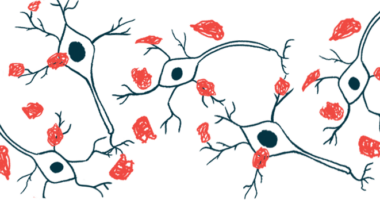Possible Parkinson’s treatment seen in template to make alpha-synuclein
Work ongoing into therapy to block RNA processes that lead to toxic protein

Scientists have developed a molecule that promotes the clearance of toxic clumps of the alpha-synuclein protein — a hallmark of Parkinson’s disease — by targeting its template rather that the protein itself.
“We have found that targeting the RNA needed to build the toxic protein may be an optimal strategy to slowing or even stopping disease progression,” Matthew Disney, PhD, chair of the chemistry department at the University of Florida’s Institute for Biomedical Innovation & Technology and the study’s lead author, said in a university social media release.
The study, “Decreasing the intrinsically disordered protein α-synuclein levels by targeting its structured mRNA with a ribonuclease-targeting chimera,” was published in the journal PNAS.
Alpha-synuclein in Parkinson’s an ‘intrinsically disordered’ protein
Parkinson’s disease is characterized by the loss of neurons, or nerve cells, that produce the neurotransmitter dopamine — a chemical messenger essential for muscle control.
Current treatment approaches for Parkinson’s work to alleviate disease symptoms, but they do not address its underlying mechanisms. While the exact triggers leading to the death of dopamine-making cells are not known, the abnormal clumping of misfolded alpha-synuclein in brain cells is considered a key factor.
“To change the course of this disease, we need to address its cause. For many Parkinson’s patients, that apparent cause is the accumulation of a toxic protein called alpha-synuclein, in and around their neurons,” Disney said.
Therapies targeting disease-promoting proteins often work by binding to specific sites within the protein itself, changing their levels or function. However, the disorganized structure of alpha-synuclein in Parkinson’s complicates work to effectively target such proteins for clearance.
“Parkinson’s disease can be caused by elevated levels of [alpha]-synuclein, an intrinsically disordered protein lacking typical small-molecule binding pockets,” the scientists wrote.
Disney and his team sought to circumvent this problem by preventing a problematic protein from being produced. Specifically, they developed a molecule that can bind to alpha-synuclein’s messenger RNA and trigger its degradation.
Protein synthesis begins with a process called transcription, where a specific segment of DNA (a gene) is used as a template to produce a complementary RNA molecule. This RNA molecule, called messenger RNA (mRNA), serves as a copy of the genetic information. Inside cells, mRNA attaches to a cellular structure called a ribosome, which acts as a molecular machine for protein synthesis. Ribosomes move along the mRNA to read its sequence and stitch amino acids — the building blocks of proteins — together until the final protein is assembled.
Each mRNA essentially has a start signal, indicating to the ribosome where to start protein assembly. Without this signal, protein production cannot begin. This is where Disney’s approach to a potential Parkinson’s therapy, called Syn-RiboTAC, binds and triggers the mRNA of alpha-synuclein for degradation.
“In Parkinson’s mouse models, we see that reducing alpha-synuclein by even 25% is therapeutically beneficial,” said Yuquan Tong, the study’s first author.
In patient-derived cells, alpha-synuclein production about 50% lower
Researchers also tested Syn-RiboTAC in neurons derived from induced pluripotent stem cell (iPCS) of Parkinson’s patients. iPSCs are stem cells generated from mature cells that can give rise to different cell types, including nerve cells.
These tests confirmed that Syn-RiboTAC could lower the mRNA levels of toxic alpha-synuclein and rescue the activity of other genes known to be affected in patients’ nerve cells.
“In studies from induced neurons of Parkinson’s patients, we see the Syn-RiboTAC strategy reduces alpha-synuclein production by about 50%. We saw that adding the RiboTAC produces a significant gain in potency,” Tong said.
Importantly, Syn-RiboTAC was specific to toxic alpha-synuclein’s mRNA and showed a better ability to cross the blood-brain barrier and reach the brain, where it’s needed, than other compounds studied. The blood-brain barrier is a highly selective membrane that shields the central nervous system (brain and spinal cord) from general blood circulation.
These scientists now are working to improve the structure of their drug-like molecule, making it suitable for clinical trials.
“The medical need for a truly disease-modifying treatment is significant, and we know that patients are awaiting better options,” Disney said. “We’re hopeful that we’re on the road to a better [day] for people living with Parkinson’s.”







